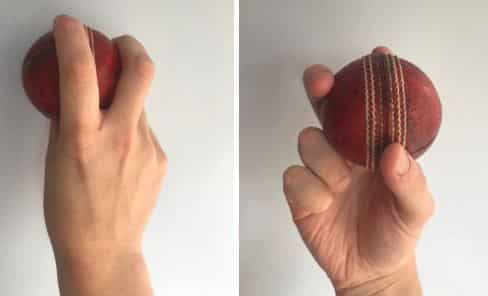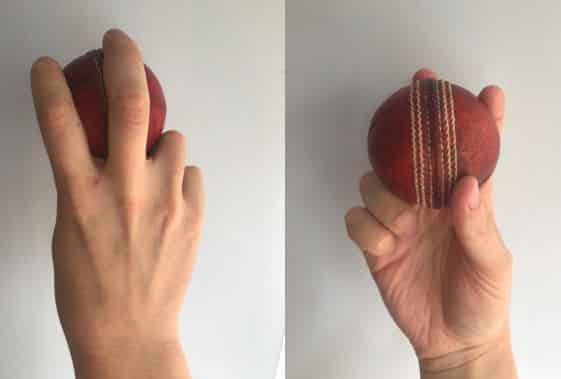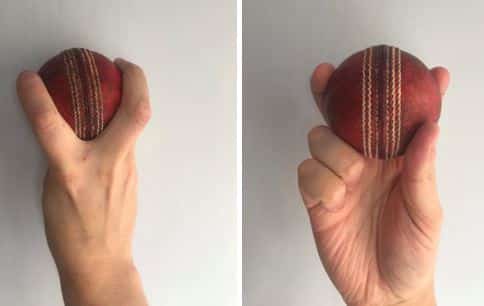There are many different types of slower balls that you will see being bowled in cricket matches. Some are more complex than others, but all of them are effective if used correctly! In this post I’m going to take you through the main ones that you will see, and I’m also going to give you advice on how to bowl each of them. Here is the list of slower balls we’ll be looking at:
- The Off-Cutter
- The Leg-Cutter
- The Split Finger Ball
- The Knuckle Ball
- The Back Of The Hand Delivery
- The S.L.O.B
But first…let me briefly answer the following question:
Why Are Slower Balls So Effective?
If a batsman is facing deliveries of 85mph every single ball, they will begin to get familiar with the pace and can start to anticipate and time their shots better, which is key when trying to hit boundaries. Fast bowlers have developed their own tricks and skills to combat this, with arguably the most deadly one being the slower ball.
By bowling a slower ball every now and again, fast bowlers are able to disrupt the batsman’s timing. If a batsman is expecting an 85mph ball, but the bowler decides to sneak in a 65mph delivery, this could lead to the batsman playing his shot too early and mistiming it. In an ideal scenario, this would lead to the batsman hitting the ball in the air for a fielder to catch, or missing it altogether and seeing his stumps shattered.
Now lets run through the types of slower ball…
The Off-Cutter
This is my personal preference of all the different types of slower ball that I’m about to show you, and it’s my go to variation whenever I’m looking to change things up during the course of an over. So I guess it’s only natural that I would list this one first! To bowl the off-cutter, you’re going to have to impart some off-spin on the ball as it leaves your hand.
How To Bowl The Off-Cutter
The process goes as follows:
- Hold the ball in the correct grip, which can be seen in the photos below. You can see that instead of having two fingers either side of the seam as we do with the basic grip; there is now only the index finger on the seam, with the middle finger resting on the right hand side of the ball.
- Approach the crease as exactly as you usually would, with the same run up and delivery stride.
- As your arm comes over and you release the ball, rotate your index and middle fingers down the right side of the ball to impart the off-spin.

The off-cutter is very simple to bowl, and getting it right comes down to having the correct grip and finger action at the point of release. The reason this ball comes out slower than a regular delivery is because regular deliveries rely on your fingers and wrist being directly behind the ball. This is what allows you to generate the power to push the ball down the pitch at a high speed. When you take away some of this force by keeping only one finger behind the seam and rotating your wrist as you release the ball, the delivery will naturally be slower.
The off-cutter also has an added advantage! Due to the slight rotation you are putting on the ball you increase your chances of the ball spinning when it hits the pitch. This can cause an extra problem for the batsman, especially on dry or wet pitches. Have a go at this one and see if it works for you!
Note: The delivery described above is an off-cutter for a right handed bowler. For left handed bowlers the principle is exactly the same, except you must rotate your index & middle fingers down the LEFT side of the ball.
The Leg-Cutter
The leg-cutter is essentially the opposite of the off-cutter. It still involves putting spin on the ball, except this time it’s in the opposite direction! This delivery always felt a tad less natural than the off-cutter to me, hence the reason why I never really chose to bowl it in practise or game scenarios! Every bowler is different though, so give it a try and see if it’s more your kind of thing…
How To Bowl The Leg-Cutter
Take a look at the steps below:
- Hold the ball in the correct grip, which can be seen in the photos below. This time we place the middle finger on top of the seam, with the index finger resting on the left side of the ball.
- Approach the crease as exactly as you usually would, with the same run up and delivery stride.
- As your arm comes over and you release the ball, run your middle and index fingers down the left side of the ball.

As mentioned with the off-cutter, this delivery comes out a lot slower due to the fingers and the wrist not being directly behind the ball upon release. By rotating your fingers down to the left, you are imparting leg-spin on to the ball, and once again, if you are lucky the ball will grip the pitch and spin to the left. I think the leg-cutter makes it a lot harder to generate spin than the off-cutter does, and I think that comes down to the finger that is resting on top of the seam. With the off-cutter we have greater control and can get a lot more revolutions on the ball as it is controlled by the index finger, whereas the leg-cutter is a lot harder to spin forcefully with the middle finger. That being said, the main focus of these slower balls is not to spin, it is to deceive the batsman with their speed! So feel free to try this one out!
Note: The delivery described above is a leg-cutter for a right handed bowler. For left handed bowlers the principle is exactly the same, except you must rotate your index & middle fingers down the RIGHT side of the ball.
The Split Finger Ball
Ok, so the first two slower balls I explained have involved imparting a small amount of spin by rotating your fingers/wrist. The split finger ball does not require you to do anything like this; it is all about the grip and getting the right level of pressure on the ball!
How To Bowl The Split Finger Ball
Check out the following steps:
- Hold the ball in the correct grip, which can be seen in the photos below. In the conventional grip, the fingers are placed either side of the seam but quite close together. With the split finger ball, you must spread them wider. It is important to place the fingers wide, but not too wide that it becomes uncomfortable.
- Approach the crease as exactly as you usually would, with the same run up and delivery stride.
- As your arm comes over and you release the ball, keep your wrist upright and try to bowl the ball as conventionally as possible. As the ball is released, the split fingers will cause the ball to escape through the gap and come out a lot slower.

This is another slower ball that relies on both fingers not being directly behind the ball to apply the force to push it down the pitch. I spent a long time practising this one and there were a lot of times when I felt as if it was very hard to control. The ball would sometimes just slip out of the top of my hand and not travel very far at all! But, if practised enough, I’m sure it can be just as deadly as all of the rest. The first bowler I remember seeing use this slower ball was Glenn McGrath, and if he was a fan of it then that tells you all you need to know!
A final bit of advice on this one would be to ensure that you do not grip the ball too tight. Try to maintain the same amount of pressure on the ball as you usually would have when bowling normally. Squeezing the ball too tightly between your split fingers can cause the ball to come out weirdly, leading to an inaccurate delivery!
The Knuckle Ball
I don’t know exactly why, but this was one of my favourite slower balls to bowl in the nets and during games. Maybe that was because you don’t hear about it that often! This is another slower ball where the placement of your index and middle fingers is crucial to bowling it correctly.
How To Bowl The Knuckle Ball
- Hold the ball in the correct grip, which can be seen in the photo below. This delivery requires you to place the surface of your fingernails flat against the surface of the ball, which takes away your ability to grip the ball very hard.
- Approach the crease as exactly as you usually would, with the same run up and delivery stride.
- As your arm rotates and you release the ball, you will feel it leave your hand in a lot ‘looser’ fashion. It is this that creates the difference in pace.

One quick point to mention regarding the steps above is that holding the ball in the grip I have shown you above can be incredibly difficult whilst you are approaching the crease. This is because you basically do not have much grip on the ball at all. One thing that bowlers will do to combat this is to run up using the conventional grip, and then switch to the knuckle ball grip just prior to releasing the ball. This could also help to deceive and confuse the batsman!
It is commonly thought that this type of delivery can also lead to other things occurring in the air too. The knuckle ball that was perfected by Zaheer Khan of India seemed to ‘dip’ very rapidly due to it having almost no revolutions on it when it left the hand. The backwards revolutions that are imparted on the ball during normal deliveries provide an upwards force that opposes gravity, so when these revolutions are not present, phenomena like this can occur!
The Back of the Hand Delivery
This is one of the more challenging slower balls out all of all the ones I’ve posted, but seems to be one of the most effective. Many professionals use the back of the hand ball expertly, and routinely cause batsmen problems by doing so. Due to the difficulty, I never practised this one in the nets for a considerable amount of time. But from the few times I did try it, I know that it will take a lot of practise to master.
How To Bowl The Back Of The Hand Delivery
- Hold the ball in the conventional grip, with your index and middle fingers either side of the seam (click here to see my post on the conventional grip for a fast bowler). There is no need for any grip adjustments with this delivery.
- Approach the crease as exactly as you usually would, with the same run up and delivery stride.
- Ensure that your bowling arm rotates as usual. However, this time, as the arm comes over you must twist it around. When you release the ball the batsman should be able to see the back of your hand rather than the palm (as is seen during conventional deliveries)
- Upon release, flick the wrist forwards so that the ball pops out of the back of your hand.
This delivery requires quite a flexible wrist, arm and shoulder to ensure the ball comes out correctly.

The photo of James Faulkner above shows the position you must get your arm into. The best bowlers of this delivery can often get the seam to remain perfectly upright as the ball travels through the air, which can confuse the batsman into thinking that it is a normal ball. The way this slower ball is bowled causes topspin to be imparted on the ball, whereas a conventional delivery will be subject to backspin. Many people think that having topspin on the ball helps it to bounce more once it hits the pitch and could make the batsman more likely to miscue and hit it up in the air to a fielder. It is also thought that the topspin makes the ball ‘dip’ on the batsman, which can help to deceive them in the flight.
In summary, this ball is incredibly hard to perfect, but if you manage to do so it can be very rewarding.
The S.L.O.B (Slower Obsolete Ball)
I actually only read about this one recently but thought I would post it so you guys can have a go! The SLOB has gained its name because it behaves very ‘lazily’ in the air, and has the tendency to dip on the batsman very suddenly. It has even been dubbed the world’s best slower ball by the coach that developed it.
How To Bowl The S.L.O.B
- Hold the ball in the conventional grip, with your index and middle fingers either side of the seam.
- Approach the crease as exactly as you usually would, with the same run up and delivery stride.
- As your bowling arm comes over and you prepare to bowl, remove your thumb from the side of the ball. This will lead to your grip looking something like the picture below.
- Release the ball using your index and middle fingers to guide it in the flight.

This ball seems like it would be very effective due to it being very hard for the batsman to spot straight from the hand. The grip will look exactly the same with the exception of the thumb being removed from the ball at the last second, which is an exceptionally tough detail for a batsman to notice! In terms of its effectiveness, a lot of the research I’ve done tells me that this delivery is especially dangerous when it is bowled on a very full length. As mentioned with the knuckle ball, the lack of rotations on the ball can cause it to ‘die’ or ‘dip’ in the flight at the last moment. This can cause the batsman to misjudge the fuller length and play the wrong type of shot.
As with the back of the hand delivery, be aware that this one might take you a while to master! The thumb is one of the main guiding elements of a bowling action, and helps us maintain accuracy. When you remove it from the ball it can affect your aim, therefore it will take some getting used to! Like all of these slower balls, practise makes perfect, so get outside and have a go!
Final Points to Note
As you can see by reading this post, there a number of different slower balls to choose from. The better you can disguise it, the more effective it will be. Remember, the batsman will be attempting to read the ball as it leaves your hand. If he notices you doing anything hugely out of the ordinary, it may give him a clue of what you are about to bowl and allow him to adjust accordingly.
Perhaps the most important thing I learned when practising bowling your slower balls is that you should never slow down your arm speed. When trying these for the first time a lot of bowlers will slow down the rotation of their arm because they wrongly believe it is the speed of the arm which will cause the ball to come out slower. However, as we have discussed many times during this post, it is the different grips and techniques that you use that cause the difference in speed! For example, consider a normal ball, and an off-cutter, both bowled with the same arm speed. The off-cutter will naturally come out slower because of the spin that has been put on the ball. The batsman could easily notice a bowler changing the speed of the arm, and that might give them a clue that a slower ball is coming. Speaking from experience, this was something that really hindered the effectiveness of my slower balls when I first started bowling them. I would slow my arm down without even realising! In my case it often caused the ball to come out far too slow, and the batsman could just wait for it and line up their shot easily. Allowing the grip to cause the difference in speed leads to the slower ball being more disguised, and a lot more deadly!
Lastly, I want to say that once you have found the slower ball that feels like the best one for you, stick with it! You rarely see professional bowlers who have more than one slower ball that they will use in game situations. They would rather focus all of their effort on perfecting one single delivery rather than spreading their time and attention across multiple different ones!
